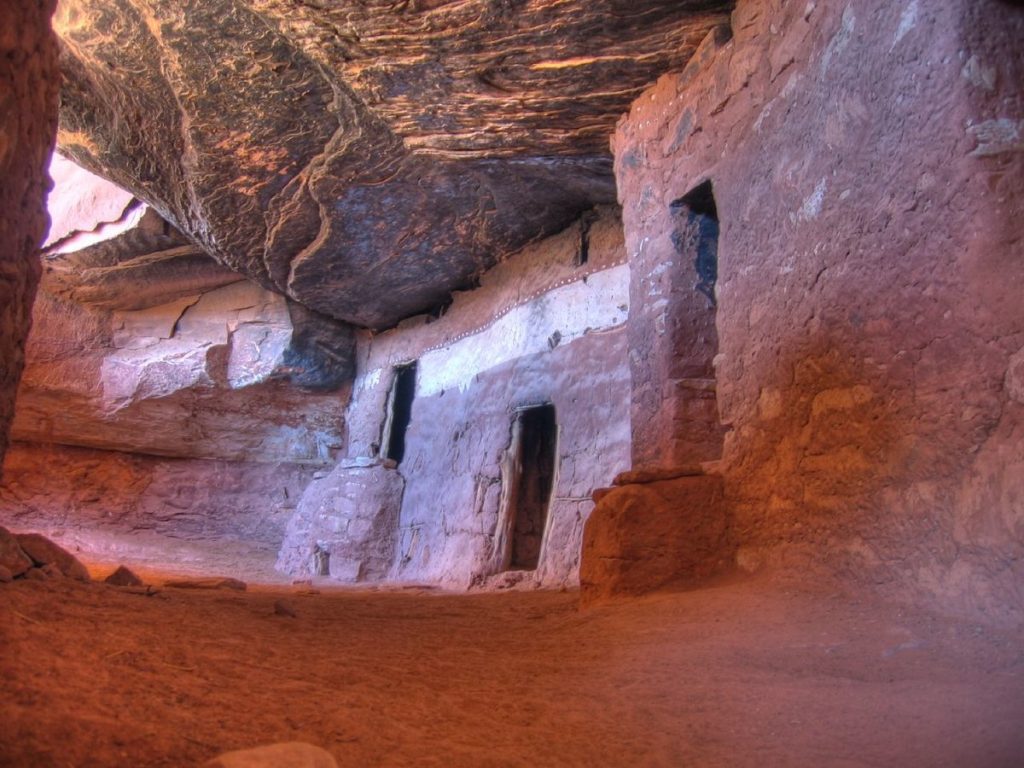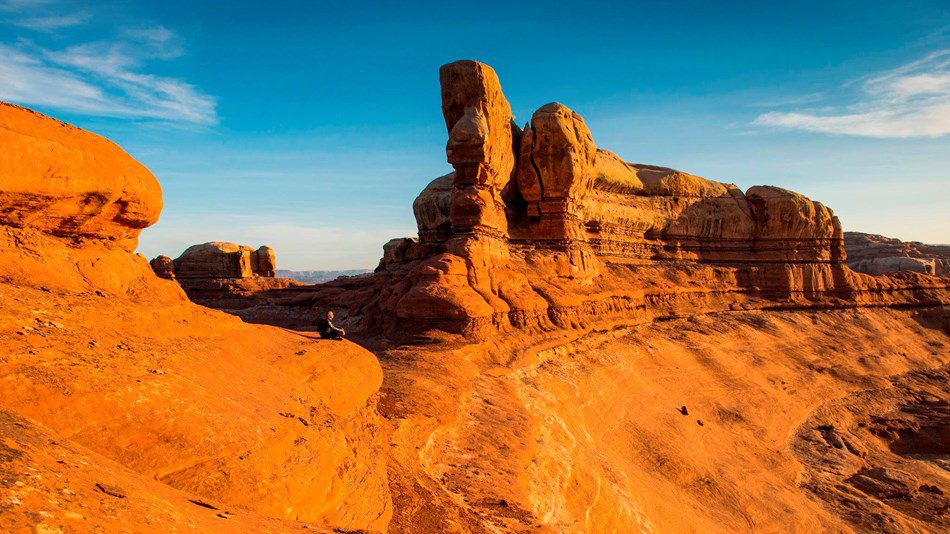
On December 4, 2017, former President Donald Trump slashed the size of Bears Ears National Monument by 85%. In a further damaging move, he reduced its sibling monument, Grand Escalante-Staircase National Monument, by another 50%. It was the first time in history any National Monument was reduced in size. In the coming days, the Biden administration will decide whether to restore the original borders of these Monuments. Despite these recent changes, Bears Ears and the lands surrounding have a long history, dating back thousands of years.
Bears Ears, which sits in south-eastern Utah, has a human history dating back 13,000 years. The people, landscape, animals, and climate have all changed in dramatic ways since the first people arrived in the region. However, the Ute Mountain Ute, the Pueblo of Zuni, the Ute Indian Tribe, the Navajo Nation, and the Hopi Tribe are all direct ancestors of these original people.
Around 11,000 CE, the Puebloan people began building large cliff dwellings and painting elaborate murals on canyon walls and in caves. These were complex civilizations. Due to frequent warfare, the cliff dwellings served as places of refuge when people came under attack. In addition to having stone walls and places to store food, the dwellings were frequently located in canyons with only one or two entrances. Enemies were hard-pressed to sneak in and take them by surprise. Both the cliff dwellings and the artwork still fill the landscapes of Bears Ears and Grand Escalante-Staircase National Monuments.

Yet, like all civilizations, the Puebloan people adapted to changing times. Many of the people, by 1290 CE had migrated south, where the Pueblo, Hopi, and Navajo reservations now are. Others migrated towards the mountains where the Paiute and the Ute now live. Just because they migrated, however, does not mean that they lost their connection to the land. The Indigenous ancestors of the Puebloan culture still visit the area regularly. They hunt and fish and gather food and medicinal plants. They visit the cliff dwellings and the carvings and paintings. In many ways, the area is still home to these people.
The thousand-year-old artifacts often draw visitors to the region, but Diné (Navajo) hogans and sweat lodges, Nuche (Ute) tipis, and Indigenous rock art sites are still visible throughout southern Utah. Indigenous reservations now ring the two monuments. These lands are often presented as places set aside for the Indigenous nations and tribes who inhabit them. But for the people who live there, they were often like prisons. In effect, they cut Native people off from sacred lands.
The reservation system was created through a collection of violent battles. In an act of genocide, the US army fought Native American tribes, massacred women and children, and forced groups of people to walk long distances, with the clear intent of reducing the Indigenous population. The Navajo reservation was built in such a way.
From 1863-1866, after a scorched earth campaign, Union soldiers removed approximately 10,000 Diné people from their traditional homes. They did not go without a fight. For example, one Navajo Headman known as Manuelito was born near Bear Ears twin buttes. Professor of American Studies at the University of New Mexico, Jennifer Nez Denetdale – who is Diné and a descendent of Manuelito – wrote that “Manuelito led his people in their resistance to forced relocation on ‘the Long Walk’ to Bosque Redondo.” Nevertheless, in 1864 they were forced to walk to New Mexico. In Dine, the event is known as Hwéeldi. Bears Ears served as a key location of resistance. According to Diné filmmaker and anthropologist Angelo Baca, during “the Long Walk, Navajo resisters fled the military incursion, sought protection in the Bears Ears area, and escaped confinement…The landscape is so rugged that the U.S. military couldn’t follow us. They didn’t know where they were going, and it was too hard on their horses, too hard on them. They’d just give up half the time.” Six hundred years after the creation of the cliff dwellings, Bears Ears continued to shelter the Navajo from danger.
While the U.S. Army worked to remove or exterminate Native nations, members of the Church of Latter-Day Saints (colloquially known as Mormons) began arriving in the region. In 1847, Mormons built their first settlement in present-day Utah on the edge of the Great Salt Lake. They named it Salt Lake City. Brigham Young, the leader of the church at the time, then sent missionaries throughout the region to establish LDS settlements. Far from finding empty lands, these settlers rapidly claimed land from the Ute, Paiute, Shoshone, Goshute, and Navajo.
In the late 1860s, four years after the Long Walk, the Army turned its sights on the Ute. The Ute, who had adopted horses following the arrival of the Spanish in the Southwest, were spread out over a huge geographical range, making their removal a long and drawn-out process. In 1868, after silver was found in the region, the first Nuche were forced onto a reservation after being pushed out of the San Juan Mountains in southern Colorado. Removal continued, ending in 1895, when members of the last Nuche band were finally imprisoned in a small sliver of land which was intended to destroy their nomadic culture, end their access to sacred sites, and to force them into the ‘civilized’ occupation of farming.
While Indigenous people were being removed, Mormon settlers began building their own historical ties with the landscape. For example, in 1879, the San Juan Mission Expedition made its way into southeastern Utah, near Bears Ears. Attempting to reach what would become the settlement Bluff, Utah, the expedition followed an older trail, long used by Native Americans in the region. However, the trail proved too narrow for their wagons. To exit a canyon, the LDS settlers famously carved and blasted a hole through a canyon wall, now called “Hole-in-the-Rock.” It is currently located in what is called the Shash Jaa Unit. LDS heritage tourism and pilgrimages demonstrate a certain reverence for the actions of LDS ancestors who took part in the Hole-in-the-Rock expedition. While LDS and Indigenous relationships to the land are culturally distinct, reverence for Hole-in-the-Rock demonstrates how the land has become significant, albeit different in meaning, to both Indigenous and settler cultures alike.
Although the era of violent removal was technically over, violence between Native nations and settlers continued. The so-called Posey War, which occurred in the spring of 1923, is one example. In March of that year, the sheriff of Blanding, Utah, named William Oliver, arrested two Nuche, Joe Bishop’s Little Boy and Sanup’s Boy for robbing sheep, killing a calf, and burning a bridge. During a recess at the trial, the two made a dramatic escape. When sheriff Oliver failed to capture his charges, he returned to town and deputized a large group of men.
Meanwhile, others from the nearby Nuche community of Westwater fled toward Navajo Mountain, a traditional place of sanctuary. The mountain sits in the center of Bears Ears National Monument. Indigenous men, who stayed back to delay their pursuers, exchanged shots with the sheriff’s men. “The Indians,” historian Robert McPherson writes, “killed a horse, barely missed three passengers in a Model T, and created a media sensation that played in newspapers as far away as Chicago.” Posey, in turn, was shot. It proved to be a fatal wound. Although Joe Bishop’s Little Boy was shot and killed instantly in one exchange, the pursuers did not recognize the man. The Utes were then imprisoned for a month until a U.S. Marshal finally found Posey’s body.
McPherson, in his contemplation of the war, writes that “for the Paiutes, [Posey’s war] was not a war and never was intended to be such. A desperate flight through the canyons, a few shots fired as a delaying action, and a very rapid surrender do not justify elevating an exodus to a war.” Nevertheless, as recently as the 1920s, Bears Ears has continued to act as a place of refuge in a long history of genocide.

Despite the violence which occurred in southern Utah, by the 1960s, members of the U.S. government were becoming aware of the historical and environmental importance of the space. In 1961, as the environmental movement began to pick up steam, Secretary of the Interior Stewart Udall proposed a 1-million-acre National Park, which would have included large parts of Bears Ears National Monument. In the end, however, the proposal was shrunk dramatically, turning into the 300,000-acre Canyonlands National Park, which today is one of the most popular in the nation.
Despite the massive expansion of public lands in the 1960s, by the mid-1990s these lands were under threat by state, local, and businesses who wanted to extract mineral wealth from them. In 1995, the Utah State Senate began promoting an anti-wilderness bill. In response, writer Terry Tempest Williams and others began pushing back. In the spring of 1996, when the bill came to the U.S. Senate floor, it was filibustered.
While building national parks was becoming increasingly difficult, the National Historic Preservation Act gave the president the power to preserve lands deemed historically significant through executive action. In the fall of 1996, invoking this power, President Bill Clinton set aside 1.9 million acres of land to create the Grand Staircase-Escalante National Monument.
While writers initiated the protection of Grand Staircase-Escalante, the current iteration of Bears Ears was first imagined by Utah Senator Robert Bennett. Bennett, a proponent of public lands, asked the Navajo if they had a vested interest in any of the lands in the area. The Diné, of course, said yes. Utah Diné Bikeyah, a non-profit organization, was formed in 2010. Diné Bikeyah (pronounced di-NAY bi-KAY-uh) means “people’s sacred land,” in Navajo/Diné. The organization answered Bennet’s call. In turn, they collected information from tribal elders and shaped an argument for why Bears Ears should be preserved to protect sacred Indigenous lands.
Unfortunately, Bennett’s process came to a halt in January of 2011 when he lost to the Tea Party Republican Mike Lee. With Lee explicitly in opposition to the maintenance or expansion of public lands, the dreams of Utah Diné Bikeyah were put on hold until a more welcoming public official was elected. Nevertheless, in preparation for that moment, the organization continued building its case. From 2014, through Obama’s executive order creating Bears Ears in 2017, Indigenous activists petitioned Congress to create the monument.
In 2015, the Inter-Tribal Coalition was formed. Navajo Nation, Ute Mountain Ute Tribe, Pueblo of Zuni, and Ute Indian Tribe came together to fight for the creation of Bears Ears National Monument. This organization brought together five tribes to protect Hoon’Naqvut, Shash Jáa, Kwiyagatu Nukavachi, Ansh An Lashokdiwe (Bears Ears in each nation’s respective language). Working together, they used GIS and oral histories to map the many sites that had historical and spiritual significance to the five tribes. As the Utah Diné Bikeyah and the Inter-Tribal Coalition worked to convince Congress that they should preserve Bears Ears, author Steven Trimble once again drew attention to the importance of the region. In Red Rocks, a collection of essays, he noted the “historical context, natural history and archaeology, energy threats, faith, and politics. Together, they offer a nuanced case for restraint and respect in this incomparable Redrock landscape.”
Diné anthropologist and activist Angelo Baca speaks on the importance of Bears Ears.
Much like Grand Staircase-Escalante, Bears Ears was stuck in a deadlock in Congress. Nevertheless, in early 2017, by executive order, Bears Ears became a National Monument. Before signing the order, President Barack Obama cited the many reasons Bears Ears should be protected, including its unique rock formations, its archeological sites, including the Cleovis period, the Archaic period, and, of course, Indigenous relics from the 12th and 13th centuries. Finally, and most importantly, he cited the area’s cultural and historical importance for Native Nations and Tribes in the area.
It proved short lived. Soon after Donald Trump was elected, Secretary of the Interior Ryan Zinke visited Utah on a four-day “listening tour,” during which he spent most of his time with anti-monument activists and politicians. In contrast, Zinke spent less than an hour with the Inter-Tribal Coalition. Both the coalition and the media understood this as a clear expression of his priorities. Zinke wanted public lands for extraction, not for public use. In a widely covered event, Zinke even wagged his finger at a protestor who was telling him he needed to meet with Indigenous people. Zinke told her to “be nice.” As Zinke toured the area, Senator Mike Lee, now supported by Donald Trump, worked to shrink the monument. He was one of the loudest voice against the creation of the monument. Even so, despite Lee and Zinke’s best efforts, neither the country nor Utah agreed with them. Republican polling firm Public Opinion Strategies released date in 2017 revealed that two thirds of voters supported the number of monuments in the country, and by the same margin, Utah voters supported keeping Bears Ears as it was.
View “Bears Ears National Monument” ClioVis Timeline in full screen here
In 2017, President Donald Trump, in a historic act, shrunk Bears Ears National Monument, opening large amounts of land for oil drilling, uranium mining, and the extraction of other raw materials. He shrunk Bears Ears by approximately 85% and Grand-Escalante by close to 50%. In the process, he put in danger local and global environments, threatened essential archeological sites, and hurt Utah’s thriving outdoor recreation industry. He also sparked a national debate about whether Presidents could shrink national monuments. In response, the Inter-Tribal Coalition and their allies (such as outdoor organizations) sued President Trump for unlawfully shrinking Bears Ears.
Throughout the Trump administration, Native and non-Indigenous people alike visited the Bears Ears region to practice both new and old traditions. For example, Indigenous activists have long held an annual Indigenous dinner, using ingredients from Bears Ears and using pre-colonial cooking techniques and foods. Indigenous people frequently connect with the land at Bears Ears in spiritual ways, as with this event.
Bears Ears Creates Bonds Through Food with Cynthia Wilson in the Indigenous Kitchen from Saharspice on Vimeo.
Following the 2020 election, President Joe Biden was inaugurated as the 46th president of the United States. Biden’s campaign website had promised that “on Day 1, Biden will also begin building on the Obama-Biden Administration’s historic conservation efforts by issuing an executive order to conserve 30% of America’s lands and waters by 2030, focusing on the most ecologically important lands and waters. . . . His administration will work with tribal governments and Congress to protect sacred sites and public lands and waters with high conservation and cultural values.”
Thank you Madame @SecDebHaaland for meeting with Tribal leaders and Coalition representatives of the Ute Mountain Ute Tribe, Zuni Pueblo, Hopi Tribe, Ute Indian Tribe, and Navajo Nation yesterday to discuss the future of the sacred #BearsEars cultural landscape. #HonorTribes pic.twitter.com/KlNSaqpRnU
— Bears Ears Inter-Tribal Coalition (@savebearsears) April 9, 2021
Currently Bears Ears is waiting to see whether the U.S. government and President Biden is willing to protect Indigenous rights. Deb Haaland (Laguna Pueblo) became the first Indigenous cabinet official when she was appointed to be the Secretary of the Interior. In 2019, in an interview with the Guardian, Secretary Haaland described a recent camping trip she had taken to Bears Ears noting that “there are some pretty amazing ruins there. . . . I don’t even like to call them ruins, because in our culture, in Pueblo culture, if you acknowledge our ancestors, they are there. . . . The spirit of the people never leaves.” This is a sentiment widely shared by Indigenous people in the region. Bears Ears is sacred, filled with the ancestors of the many groups who have continuously inhabited the region.
Today, the Inter-Tribal Coalition, and many other Indigenous and non-Indigenous people are eager to see whether Bears Ears will be included in the massive expansion of public lands that Biden promised during his election.
Jesse Ritter is a Ph.D. candidate in the Department of History at the University of Texas at Austin.
_________________________________________________________________________________________
The views and opinions expressed in this article or video are those of the individual author(s) or presenter(s) and do not necessarily reflect the policy or views of the editors at Not Even Past, the UT Department of History, the University of Texas at Austin, or the UT System Board of Regents. Not Even Past is an online public history magazine rather than a peer-reviewed academic journal. While we make efforts to ensure that factual information in articles was obtained from reliable sources, Not Even Past is not responsible for any errors or omissions.



